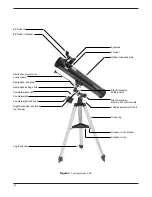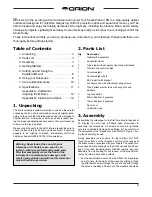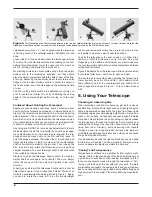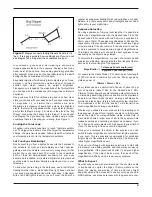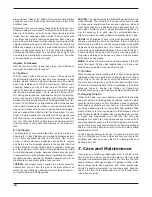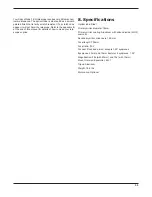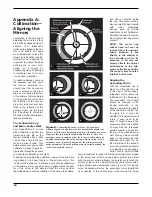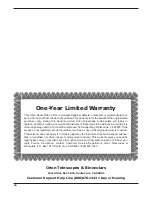
Appendix A:
Collimation—
Aligning the
Mirrors
Collimation is the process of
adjusting the mirrors so they
are perfectly aligned with one
another.
Your telescope’s
optics were aligned at the fac-
tory, and should not need
much adjustment unless the
telescope is handled roughly.
Accurate mirror alignment is
important to ensure the peak
performance of your tele-
scope, so it should be
checked regularly. Collimation
is relatively easy to do and
can be done in daylight.
To check collimation, remove
the eyepiece and look down
the focuser drawtube. You
should see the secondary
mirror centered in the draw-
tube, as well as the reflection
of the primary mirror centered
in the secondary mirror, and
the reflection of the second-
ary mirror (and your eye) cen-
tered in the reflection of the
primary mirror, as in Figure
8a. If anything is off-center,
proceed with the following col-
limation procedure.
The Collimation Cap
and Mirror Center Mark
Your SpaceProbe 3 comes
with a collimation cap. This is a
simple cap that fits on the
focuser drawtube like a dust
cap, but has a hole in the cen-
ter and a silver bottom. This
helps center your eye so that
collimation is easy to perform.
Figures 8b through 8e assume
you have the collimation cap in place.
In addition to providing the collimation cap, you’ll notice a tiny
ring (sticker) in the exact center of the primary mirror. This
“center mark” allows you to achieve a very precise collimation
of the primary mirror; you don’t have to guess where the cen-
ter of the mirror is. You simply adjust the mirror position
(described below) until the reflection of the hole in the collima-
tion cap is centered inside
the ring. This center mark is
also required for best results
with other collimating
devices, such as Orion’s
LaserMate Laser Collimator,
obviating the need to remove
the primary mirror and mark it
yourself.
NOTE: The center ring
sticker need not ever be
removed from the primary
mirror.
Because it lies
directly in the shadow of
the secondary mirror, its
presence in no way ad-
versely affects the optical
performance of the tele-
scope or the image quality.
That might seem counter-
intuitive, but it’s true!
Aligning the
Secondary Mirror
With the collimation cap in
place, look through the hole
in the cap at the secondary
(diagonal) mirror. Ignore the
reflections for the time being.
The secondary mirror itself
should be centered in the
focuser drawtube, in the
direction parallel to the length
of the telescope. If it isn’t, as
in Figure 8b, it must be
adjusted. This adjustment will
rarely, if ever, need to be
done. It helps to adjust the
secondary mirror in a brightly
lit room with the telescope
pointed toward a bright sur-
face, such as white paper or
wall. Placing a piece of white
paper in the telescope tube
opposite the focuser (i.e., on
the other side of the second-
ary mirror) will also be helpful
in collimating the secondary
mirror. Use a small Phillips
head screwdriver to loosen the three small alignment screws
in the center hub of the 3-vaned spider several turns. Now
hold the mirror holder stationary (be careful not to touch the
surface of the mirrors), while turning the center screw with a
larger Phillips head screwdriver (see Figure 9). Turning the
screw clockwise will move the secondary mirror toward the
front opening of the optical tube, while turning the screw
Figure 8.
Collimating the optics. (a) When the mirrors are
properly aligned, the view down the focuser drawtube should look
like this. (b) With the collimation cap in place, if the optics are out of
alignment, the view might look something like this. (c) Here, the
secondary mirror is centered under the focuser, but it needs to be
adjusted (tilted) so that the entire primary mirror is visible. (d) The
secondary mirror is correctly aligned, but the primary mirror still
needs adjustment. When the primary mirror is correctly aligned, the
“dot” will be centered, as in (e).
12
a.
b.
c.
d.
e.
Summary of Contents for SpaceProbe 3 EQ 9844
Page 15: ...15 ...


